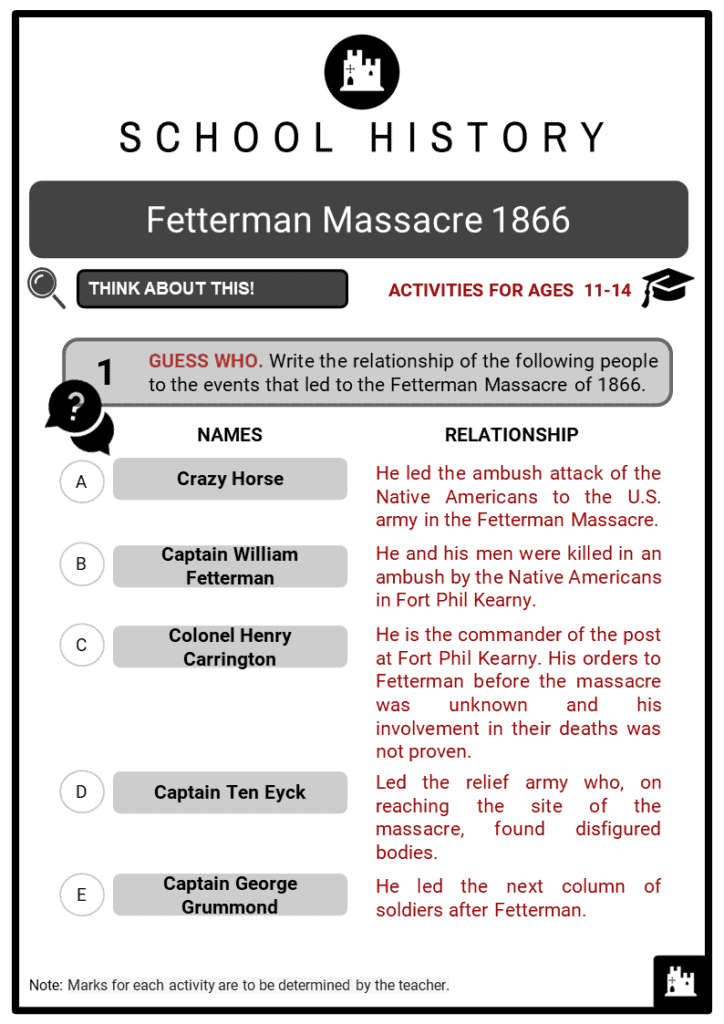Download Fetterman Massacre 1866 Worksheets
Do you want to save dozens of hours in time? Get your evenings and weekends back? Be able to teach Fetterman Massacre 1866 to your students?
Our worksheet bundle includes a fact file and printable worksheets and student activities. Perfect for both the classroom and homeschooling!
Table of Contents
Add a header to begin generating the table of contents
Summary
- The Origin of the Names: Fetterman Massacre and Battle of the Hundred Slain
- Prior events leading to the Fetterman Massacre
- The Fetterman Massacre
- Events after the Fetterman Massacre
Key Facts And Information
Let’s know more about Fetterman Massacre 1866!
- The Fetterman Massacre (also called Fetterman Fight or Battle of the Hundred Slain) is one of the events of the Great Sioux Wars. On the 21st of December 1866, the Lakota, Cheyenne and Arapaho warriors lured Captain William Fetterman and his men into an ambush attack at Fort Phil Kearny, Wyoming to retaliate for trespassing treaty lands. The events of the Fetterman Massacre led to the withdrawal of federal government interest over the Sioux Territory, ending the Red Cloud’s War with the second Treaty of Fort Laramie in 1868.
The Origin of the Name
- The ambush attack on the U.S. army by Lakota, Cheyenne and Arapaho warriors at Fort Phil Kearny is popularly known as the Fetterman Massacre or Fetterman Fight.
- This event in the Great Sioux Wars, however, is called differently by Native Americans: to them, it is to be called the Battle of the Hundred Slain — a name that was given as a promise to Red Cloud, the leader of the Oglala Lakota tribe, to kill a hundred soldiers.
Prior Events that Led to the Massacre
- Fort Phil Kearny was one of the forts in the Bozeman Trail to the Montana gold fields that were meant to protect the settlers from Native American attacks.
- During the Red Cloud War against the Lakota, Northern Cheyenne and Northern Arapaho, led by Chiefs Red Cloud and Crazy Horse, the Native Americans used guerrilla warfare as a military tactic.
- Through the gorilla tactics of these Native Americans, they were able to undermine the strong federal armies through irregular ambush attacks of the troops when they were least prepared.
- Commander of the post, Colonel Henry Carrington, became aware of the Native Americans’ fighting tactics.
- At the time, he was facing a shortage of men and war equipment, and Red Cloud was in control of the greater part of the region surrounding the fort.
- In November, Captain William Fetterman was sent to Fort Phil Kearny to support Colonel Carrington.
- Fetterman strongly criticised Carrington’s tactics. He spoke in contempt of the Native Americans’ fighting ability and bragged that ‘his skills could ride through the entire Sioux nation with 80 men’.
- At the same time, Red Cloud’s army started taunting the troops at the fort, attempting to lure them into ambushes using decoys and provoking them.
- They actually failed several times before eventually succeeding.
The Massacre
- In December, Fetterman was sent to retrieve a wood-gathering party that had come under attack by the Native Americans (specifically the Lakota, Cheyenne and Arapaho warriors) a few miles northwest of the fort.
- Carrington gave Fetterman an army of 80 men and express orders to ‘not engage or pursue the Indians’.
- Later, another column under Captain George Grummond was sent after Fetterman. They were deployed later because it took time to prepare their weaponry.
- Fetterman was successful in rescuing the wood parties, but the Indians taunted and frustrated Fetterman as he moved deeper into the woods.
- Instead of retreating, Fetterman deployed his infantry, and they were ambushed and murdered within 30 minutes by Crazy Horse and his men. Carrington heard the noise from the attack and sent another relief army, led by Captain Ten Eyck, who on reaching the site found disfigured bodies. The entire group of U.S. soldiers, including Fetterman, died.
Events After the Massacre
- The U.S. government launched an inquiry into the massacre, and Colonel Carrington defended himself by maintaining that Fetterman was reckless and insubordinate. Other officers contradicted his testimony, swearing under oath that Carrington ordered Fetterman to engage.
- However, the truth as to what orders Fetterman was given will never be known as Carrington was the only surviving witness of the discussion between Fetterman and Grummond.
- The U.S. government decided to exit from the region, ending the Red Cloud’s War with the second Treaty of Fort Laramie in 1868.
- The prospect of gold in the region, however, meant that there was continued conflict between the Native Americans and the settlers.
- A monument in honour of Fetterman stands at the Fetterman Massacre site and is managed by the State of Wyoming.
- The Fetterman Massacre “reignited the anti-Indian settlement that had flared in the eastern states after the Sioux Uprising of 1862” (Encyclopaedia Britannica Editors, no date). It became the U.S. army’s worst defeat on the Northern Plains. That is, until the Battle of Little Bighorn in 1876.
Image sources:








